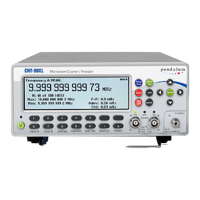8-39 Command Reference
:FORMat :SMAXCNT-91
8 <Numeric value>
Upper Limit for Array Size
Sets or queries the upper limit for :FETCh:ARRay? MAX command in number of
samples. The command is intended for use with any controllers or application pro
-
grams that cannot read large amounts of data, when the functionality of the
:FETCh:ARRay? MAX command is still interesting.
Parameter: Integer N, where 4 £ N £ 10000
Returned format: <Numeric value)¿
Power ON default value: 10000
*
RST condition:
Not affected
Format Examples:
The response formats for REAL and PACKed are described on page 8-34, but also
depend on the setting of FORMAT:BORDer. If you are using an Intel platform, you
will either have to swap all bytes, or set FORMAT:BORDER SWAP to get lit
-
tle-endian byte order as opposed to the normal big-endian order.
Here is a sample with the same measurement result in various formats:
FORMAT ASCII
+4.9999999999E+05,+7.6433000000000E+02\n
FORMAT:BORDER SWAP;:FORMAT REAL;:FETC?
23 31 38 ad 74 fd ff 7f 84 1e 41 2c 23 31 38 71 3d 0a d7 a3 e2 87 40 0a
The bit pattern is interpreted as #18<Val>,#18<TS>\n. Val and TS are 64-bit dou-
ble precision floating point numbers, least significant byte first.
FORMAT:BORDER SWAP;:FORMAT PACK;:FETC?
23 32 31 36 ad 74 fd ff 7f 84 1e 41 00 24 24 72 27 b7 02 00 0a
The bit pattern is interpreted as #216<Val><TS>\n. Val is a 64-bit double precision
floating point number, while TS is a 64 bit integer with number of picoseconds
since a reference time, least significant byte first.
FORMAT:BORDER NORM;:FORMAT REAL;:FETC?
23 31 38 41 1e 84 7f ff fd 74 ad 2c 23 31 38 40 87 e2 a3 d7 0a 3d 71 0a
The bit pattern is interpreted as #18<Val>,#18<TS>\n. Val and TS are 64-bit dou
-
ble precision floating point numbers, most significant byte first.
FORMAT:BORDER NORM;:FORMAT PACK;:FETC?
23 32 31 36 41 1e 84 7f ff fd 74 ad 00 02 b7 27 72 24 24 00 0a
The bit patttern is interpreted as #216<Val><TS>\n. Val is a 64-bit double precision
floating point number, while TS is a 64 bit integer with number of picoseconds
since a reference time, most significant byte first.

